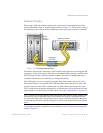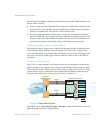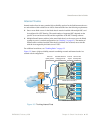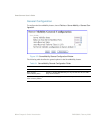SmartConnect User’s Guide
BMD00082, February 2009 Chapter 3: Switch Virtualization
33
Statistical Load Distribution
Network traffic is statistically distributed between external ports in a trunk. The switch uses
the source and destination IP address information present in each transmitted IP frame to deter-
mine load distribution. If the frame is not an IP frame, then Layer 2 MAC addresses are used.
Each packet’s particular combination of source and destination addresses results in selecting
one line in the trunk for data transmission. If there are enough devices feeding the trunked
lines, then traffic distribution becomes relatively even.
Built-In Fault Tolerance
Since trunks are comprised of multiple physical links, each trunk is inherently fault tolerant.
As long as one connection is available, the trunk remains active.
Statistical load distribution is maintained when a port in a trunk is lost or returned to service.
Link Aggregation Control Protocol
Link Aggregation Control Protocol (LACP) is an IEEE 802.3ad standard for grouping several
physical ports into one logical port (known as a dynamic trunk group or Link Aggregation
Group) with any device that supports the standard. Please refer to IEEE 802.3ad-2002 for a full
description of the standard.
The 802.3ad standard allows standard Ethernet links to form a single Layer 2 link using the
Link Aggregation Control Protocol (LACP). If a link in a LACP trunk group fails, traffic is
reassigned dynamically to the remaining link or links of the dynamic trunk.
To configure LACP for a VSG, choose Virtual Switch Groups > Settings in the BBI. The
Link Aggregation Control Protocol field can be used to enable or disable LACP. When
enabled, external ports in the VSG participate in LACP. When disabled (as by default), exter-
nal ports in the VSG’s external trunk act as a static trunk.
Switch Failover
The primary application for switch failover is to support Network Adapter Teaming. With Net-
work Adapter Teaming, the NICs on each server all share the same IP address and are config-
ured into a team. One NIC is the primary link, and the other is a standby. For details, refer to
“Configuring Teaming” in the Broadcom NetXtreme™ Gigabit Ethernet Adapter User Guide.


















